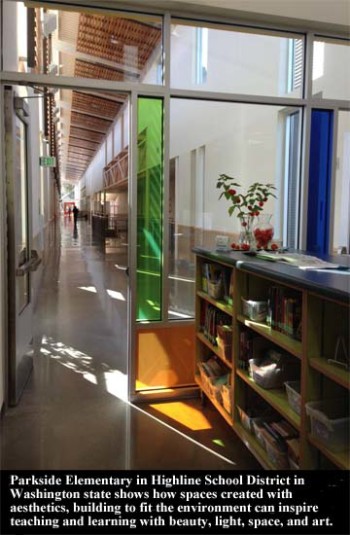Above Photo: From LivingInDialogue.com.
In the past 13 years of No Child Left Behind and Race to the Top test-driven education policies, art has been pushed to the margins in our schools. Students have lost countless hours for creating art, music and dance that expresses themselves. But artistic expression is like the seedling that forces its way through cracks in the asphalt. This blog series will explore how students and teachers use art to express themselves.
The series was inspired by a Facebook post authored by artist and kindergarten teacher Susan DuFresne. She wrote:
Art is healing and meditative for children and teachers. It is inspiring and allows a different kind of space for free and creative expression. Art builds self-confidence in a way that children need. It develops listening skills and an ability to work from part-to-whole. It develops trust in one’s teacher.
Art develops executive functioning skills, impulse control, delayed gratification skills, planning and organizing skills, fine motor skills, and visual spatial skills. Art develops meta-cognition skills, problem-solving and critical thinking skills. Art increases experiences of joy in all children and during the process of a shared joyful Art experience, our immune systems get the same kind of boost as a hug provides. Shared Art experience creates a strong sense of community. Art creates a sense of peace and satisfaction. Art creates children who think outside the box and can help students stand up for themselves and others. Art develops empathy. Art helps us learn about our world sometimes in a way nothing else could replace. Art can be full-on play! Art can create wonder and Art can answer wonderings. Art can be fiction or non-fiction. Art can come from within or from a power outside of oneself. #Art can incite emotion. Art can be visual music with rhythm and a melody of pattern. Art can engage all of our senses. Art can be science. Art is math. Art is visual poetry. Art can be social studies. Art can incite social justice! Art can be dangerous to the elite! Art can disrupt and disturb oppression. Art can heal depression and trauma. Art is worth doing for the sake of Art alone, but Art does all these things!
In a series of blog posts by students, parents, and teachers we will explore, create, and persuade through creative alternatives offered to test and punish schooling.
In a recent blog post by Adam Rosenblatt, he said: “Beauty is why we teach and how we learn.”
What do we mean when we say “art”. Here we mean to include all of the “arts” – the humanities – and free creative play. We will explore examples of each, for in each there is true beauty. Our vision of schools in their design of environment and pedagogy must prioritize beauty.
First, we recommend closing the chapter on the dark ages of NCLB test and punish policies, creatively resisting through an education Renaissance – believing in a value system that would lift all children up rather than test and punish them – creating safe spaces and aesthetically rich environments through No Art Left Behind.
Art is a creative process, and in harmony with this process, we begin by giving space to authentic voices, to diverse and multicultural values through providing creative space for authentic examples in hopes of community-based policies that will build the power to resist colonization of our public schools.
In our blog post series, we will paint a picture of what creative community schools of beauty can bring in contrast to reformers vision of overcrowded, stark institutions. We will expose and create an alternative vision based a a completely different purpose for educating our youth, a vision that is designed by artist teachers, parents, and students – a vision inclusive of diverse cultures that would shape social and community values through artful resistance leading to empowerment. Our values will determine our future.
As we value the voices in the margins, we will include diverse voices. Together, we challenge the din of propaganda – the chorus of the elite. In the end, as Robert L. Peters points out: “Design creates culture. Culture shapes values. Values determine the future.”
How have the test and punish policies of the past decade marginalized your voice, your values, your culture? What is the purpose of public education? Whose voices should determine the policies of public education? What policies do you want to see left behind/included?
We are gathering the diverse and authentic voices of children, our young adults, parents, community members, administrators, teachers, and professors of education. Are you interested in writing for our blog series? Please contact us atlifesabeach48@msn.com, and Anthony_cody@hotmail.com
Please visit and like the No Art Left Behind Facebook page.



